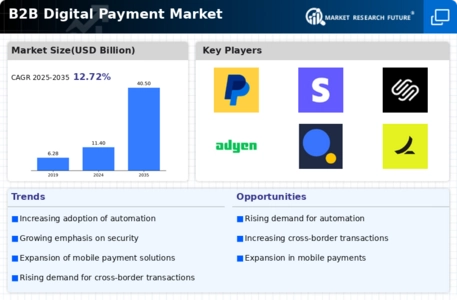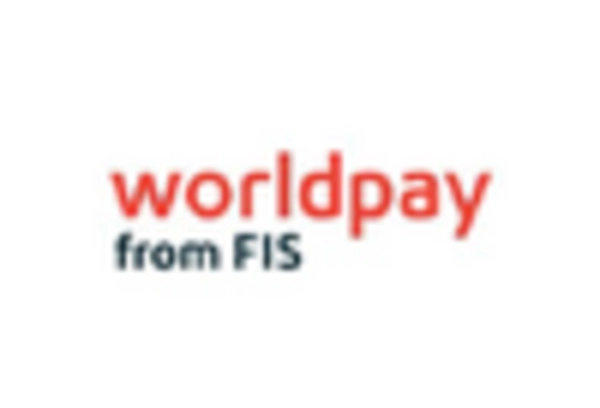The B2B Digital Payment Market is currently characterized by a dynamic competitive landscape, driven by rapid technological advancements and evolving customer expectations. Key players such as PayPal (US), Stripe (US), and Adyen (NL) are at the forefront, each adopting distinct strategies to enhance their market positioning. PayPal (US) continues to innovate its payment solutions, focusing on integrating advanced security features and expanding its service offerings to cater to a diverse clientele. Meanwhile, Stripe (US) emphasizes its developer-friendly platform, which allows businesses to customize payment solutions, thereby enhancing user experience and operational efficiency. Adyen (NL) positions itself as a global payment processor, leveraging its unified commerce approach to streamline transactions across various channels, which appears to resonate well with businesses seeking seamless integration.
The competitive structure of the B2B Digital Payment Market is moderately fragmented, with numerous players vying for market share. This fragmentation is indicative of the diverse needs of businesses across different sectors, prompting companies to adopt localized strategies. For instance, firms are increasingly focusing on optimizing their supply chains and localizing their services to better meet regional demands. The collective influence of these key players shapes the market dynamics, as they continuously adapt to technological changes and customer preferences.
In August 2025, PayPal (US) announced a strategic partnership with a leading fintech firm to enhance its blockchain capabilities. This move is significant as it positions PayPal to leverage blockchain technology for improved transaction transparency and security, potentially attracting a new segment of tech-savvy businesses. Such partnerships may also facilitate faster transaction processing, which is increasingly critical in the B2B space.
In September 2025, Stripe (US) launched a new suite of AI-driven tools aimed at automating payment reconciliation processes for businesses. This initiative is noteworthy as it reflects Stripe's commitment to harnessing artificial intelligence to streamline operations, thereby reducing manual errors and enhancing efficiency. The integration of AI into payment processes could serve as a competitive differentiator, allowing Stripe to offer superior service to its clients.
In July 2025, Adyen (NL) expanded its operations into the Asia-Pacific region, establishing new partnerships with local banks to facilitate smoother payment processing. This expansion is strategically important as it allows Adyen to tap into a rapidly growing market, where digital payment adoption is surging. By aligning with local financial institutions, Adyen enhances its credibility and operational capabilities in a region characterized by diverse payment preferences.
As of October 2025, the B2B Digital Payment Market is witnessing trends that emphasize digitalization, sustainability, and the integration of artificial intelligence. Strategic alliances are increasingly shaping the competitive landscape, as companies recognize the value of collaboration in enhancing service offerings and operational efficiencies. Looking ahead, competitive differentiation is likely to evolve, with a shift from traditional price-based competition towards innovation, technological advancements, and supply chain reliability. This transition underscores the importance of agility and responsiveness in meeting the ever-changing demands of the market.

















Leave a Comment